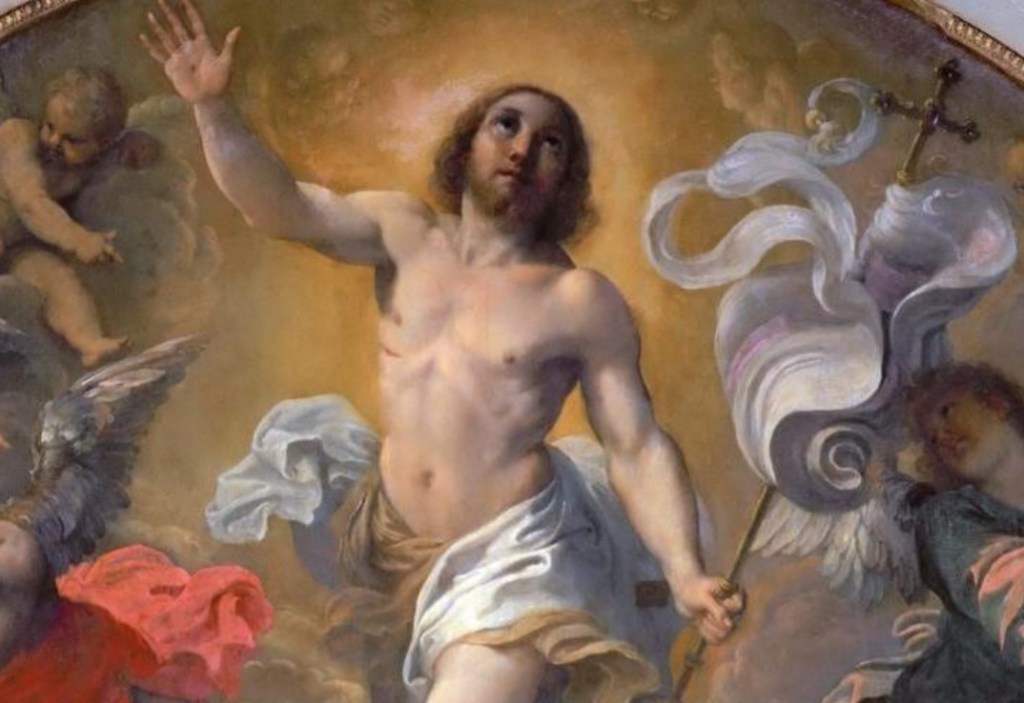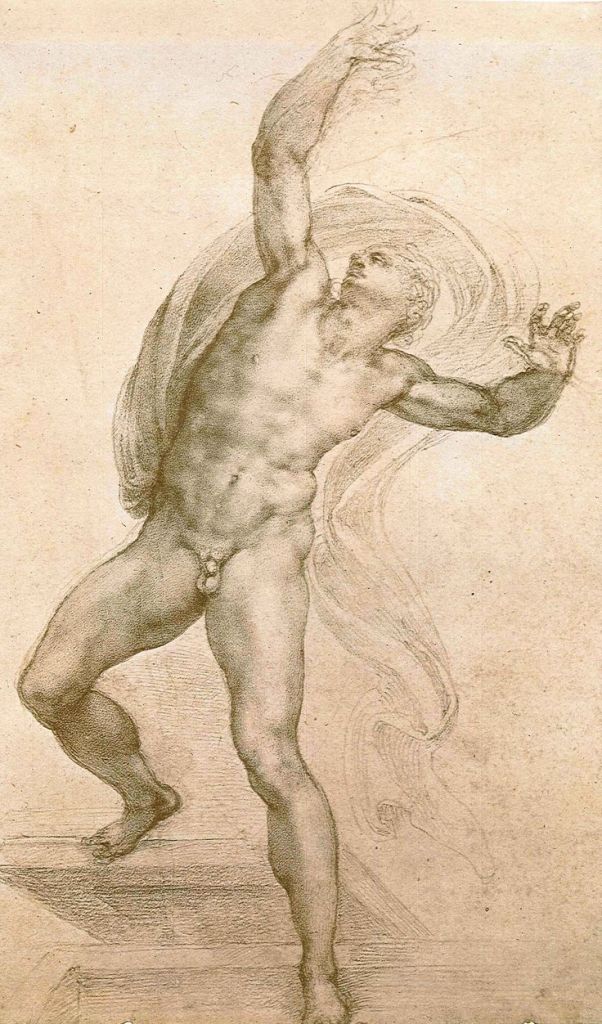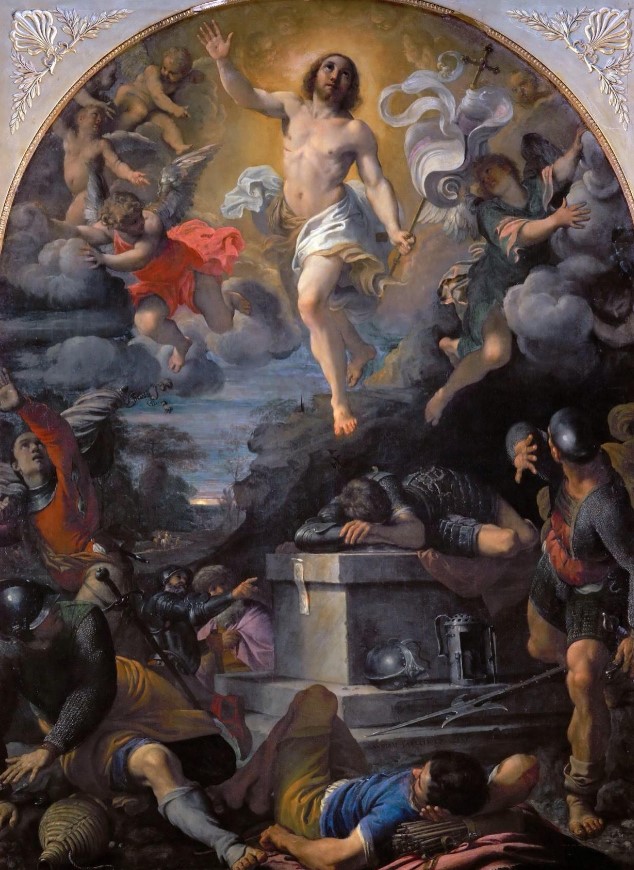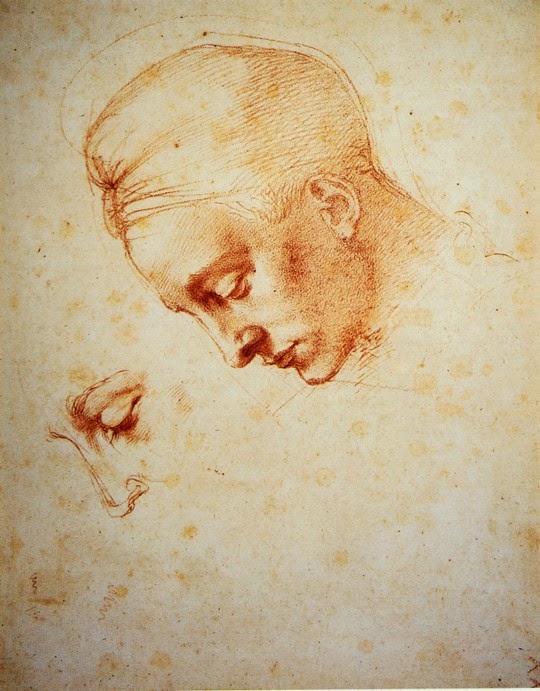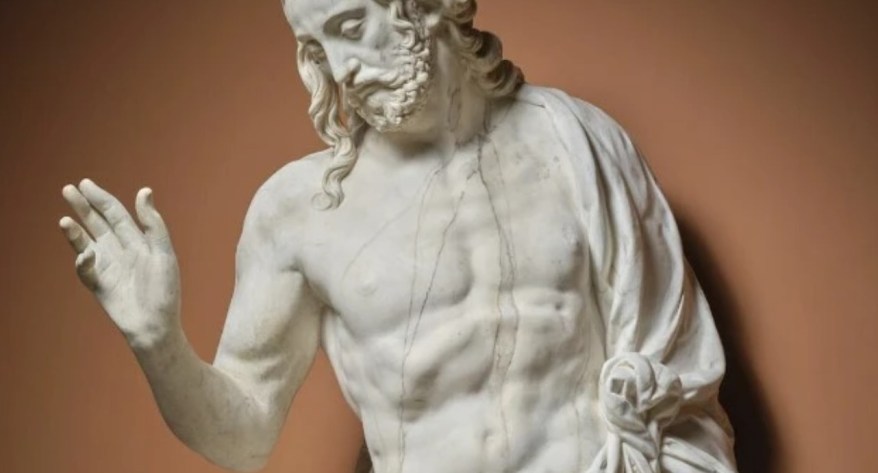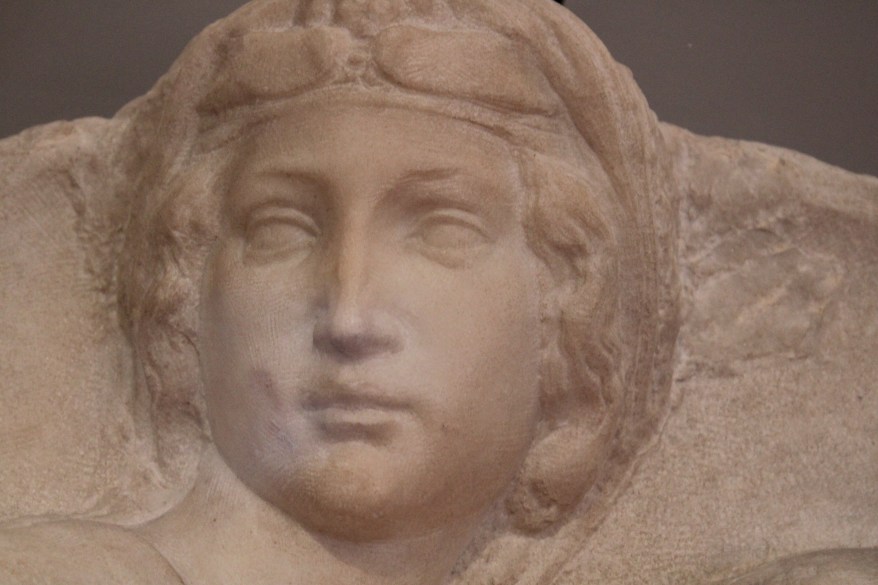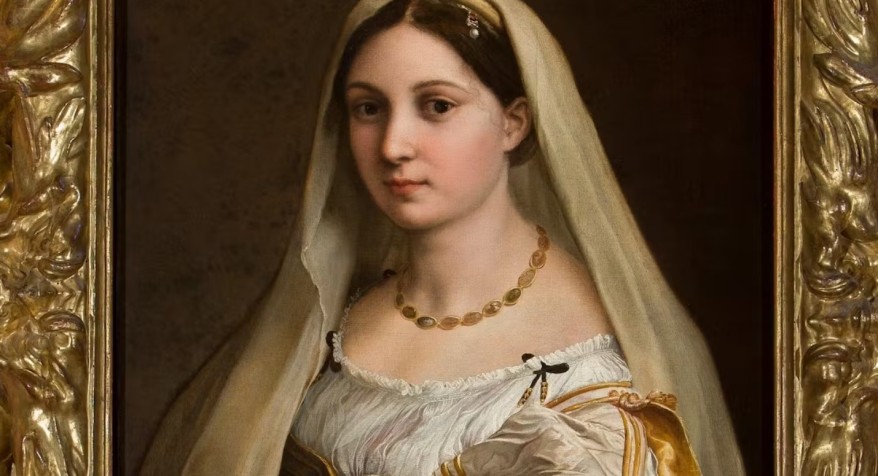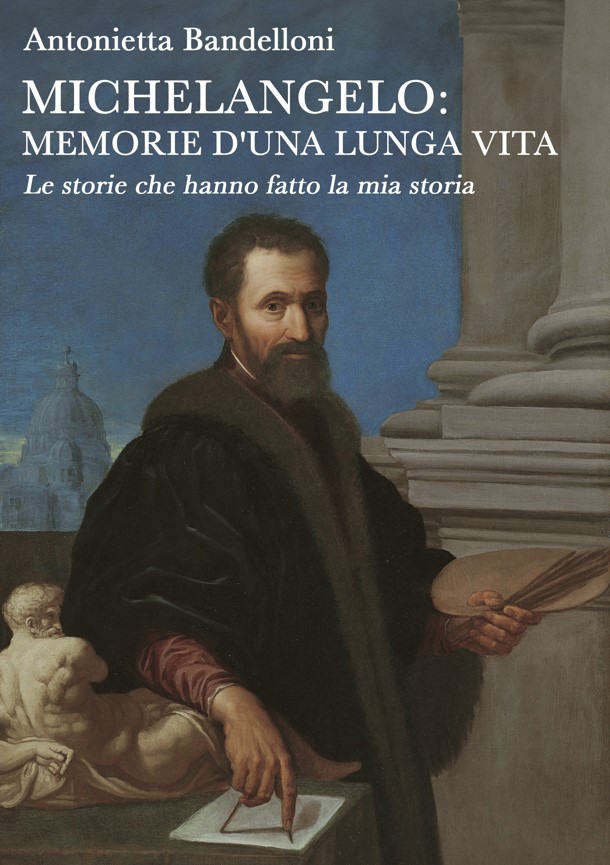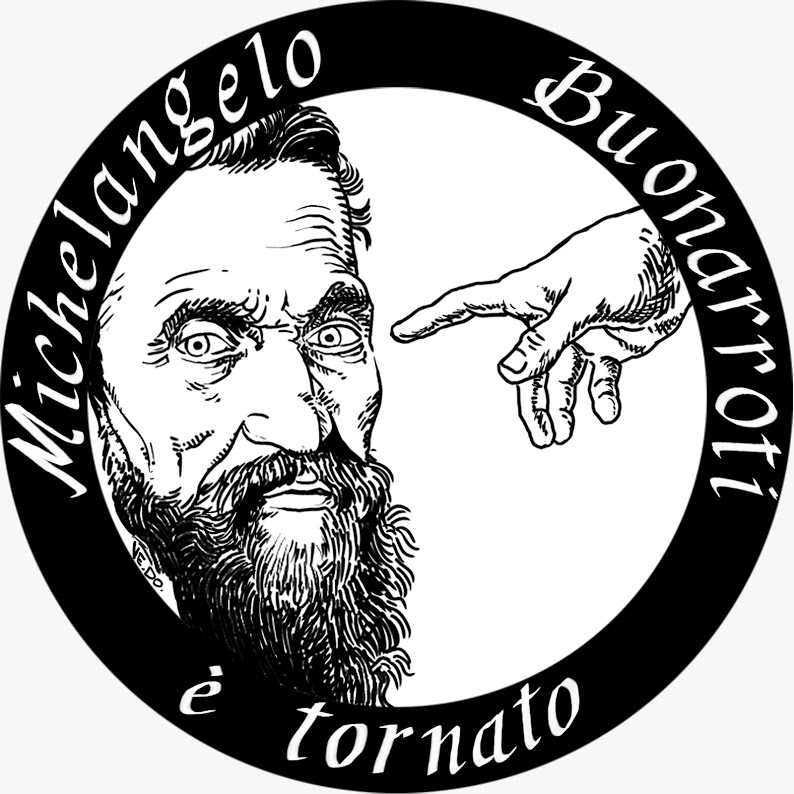Pasqua in arte: la Resurrezione dipinta
La Resurrezione di Cristo è uno dei temi più importanti e ricorrenti nell’arte cristiana. Sono tanti gli artisti che si sono confrontati sul tema e lo feci pure io sebbene mi limitai a disegnare questo momento fondamentale per la cristianità.
Se penso alla Pasqua dipinta mi viene in mente il Cristo trionfante sulla morte di Piero della Francesca ma anche il Cristo che risorge con più fatica, realizzato da Donatello per il pulpito della Basilica di San Lorenzo.
Vediamo assieme alcune delle raffigurazioni più note della Resurrezione, cominciando da un mio disegno.
Un mio disegno con la Resurrezione
Il Cristo si eleva verso l’alto e sembra pare rispondere improvvisamente alla chiamata del Cielo che lo attende. Con il sudario crea una sorta di arco al di sopra della testa.
Proprio l’atteggiamento del corpo e i tratti che delineano la testa e il volto ricordano da vicino Giona, ovvero il profeta che si sarebbe trovato immediatamente sopra questa figura, una volta affrescata sulla parete dell’altare della Sistina.
Dovete sapere che in origine papa Clemente VII pensò di farmi affrescare la parete dietro l’altare della Cappella Sistina con una grande Resurrezione di Cristo e questo molto probabilmente è un primo studio per quel lavoro poi alla fine, dopo diverse discussioni, scelse la rappresentazione del Giudizio Universale.
Il disegno appartiene alla Royal Library del castello di Windsor di Londra
La Resurrezione di Piero della Francesca
Piero della Francesca affrescò un Cristo dal corpo atletico che esce vittorioso dal sepolcro panneggiato con un drappo rosso. Ha sconfitto la morte.
Appoggia il piede destro sul bordo della tomba mentre eleva al cielo il vessillo bianco con croce rossa. Ai suoi piedi ancora dormono ignari i soldati romani.
L’affresco fu realizzato fra il realizzato fra il 1450 e i 1463, oggi dopo essere stato strappato si trova al Museo Civico di Sansepolcro.

La Resurrezione del Beato Angelico
Il Beato Angelico affrescò fra il 1438 e il 1440 nella cella 8 del dormitorio del Convento di San Marco, a Firenze, la Resurrezione di Gesù Cristo e pie donne al sepolcro.
La scena si svolge in un ambiente scuro. Cristo completamente vestito di una bianca tunica, si eleva dal sepolcro con una palma in mano e il vessillo crociato nell’altra.
Mentre guarda dritto negli occhi lo spettatore, al di sotto di Lui le pie donne appaiono sconvolte mentre l’angelo, seduto sulla tomba, racconta loro cosa è appena accaduto.
La Resurrezione di Cristo di Raffaello
Raffaello si cimentò con il tema della Resurrezione in una delle sue prime opere fra il 1501 e il 1502, oggi conservata al Museo d’Arte di San Paolo in Brasile. In realtà l’attribuzione di questa opera ancora fa discutere e non tutti gli esperti concordano con la sua paternità all’urbinate.
E’ un dipinto a olio su tavola, realizzato nel periodo in cui il modo di dipingere molto si avvicinava allo stile del Pinturicchio, caratterizzato da colori luminosi e brillanti e la cura dei dettagli più minuti, tipica dei codici miniati.

La Resurrezione di Tiziano
La Resurrezione dipinta da Tiziano fa parte del Polittico Averoldi che si trova a Brescia, nella collegiata dei Santi Nazaro e Celso.
Tiziano dipinse a olio su tavola, fra il 1520 e il 1522 Cristo che risorge tenendo nella mano destra il vessillo crociato mentre nella parte più bassa del dipinto un gruppo di soldati lo osserva.

La Resurrezione di Andrea Mantegna
La Resurrezione del Mantegna è un dipinto a tempera su tavola datato fra il 1457 e il 1459, appartenente alle collezioni del Musée des Beaux-Arts di Tours. In origine il dipinto era uno dei pannelli della predella della Pala di San Zeno che includeva anche l’Orazione nell’Orto e la Crocifissione.
L’opera fu commissionata all’artista perlomeno prima del 1475 e fu realizzata nella sua bottega a Padova per essere poi fatta arrivare a destinazione a Verona un paio d’anni più tardi.

La Resurrezione di Tintoretto
Tintoretto e la sua bottega affrontano il tema mettendo Cristo che risorge al centro della scena, avvolto da una luce che lo fa risplendere, in netto contrasto con l’atmosfera notturna.
Un po’ come nell’opera di Piero della Francesca proposta prima, ai piedi del sepolcro continuano a dormire senza rendersi conto di cosa sta accadendo dinnanzi a loro.

La Resurrezione di Annibale Caracci
Questo dipinto a olio su tela di Annibale Caracci è conservato al Museo del Louvre ed è conosciuto anche con il nome di Resurrezione Angelelli, dal nome della famiglia che per molto tempo fu proprietaria di questo capolavoro.
L’opera fu realizzata per la cappella privata di Palazzo Luchini a Bologna e successivamente fu ceduta alla famiglia Angelelli per poi essere donata al convento di Bologna del Corpus Domini, trovando collocazione nella cappella di Santa Caterina de’ Virgi.
La mano lunga di Napoleone arrivò anche qua e requisì l’opera nel 1797 per non fare più ritorno nella patria natia.
La Resurrezione di Cristo di Rubens
Nella Resurrezione di Cristo dipinta a olio su tela di Rubens, Nostro Signore esce dal sepolcro trionfante. I segni della passione sono appena accennati e non intaccano la bellezza del suo Corpo. Con una mano regge presumibilmente il vessillo crociato del quale però si vede solamente l’asta.
La corona di spine non è più sul capo ma viene tenuta da due angioletti in volo. La luce emanata da Cristo rischiara la scena e illumina le altre figure presenti.

La Resurrezione di Cristo con Papa Alessandro VI inginocchiato di Pinturicchio
La Resurrezione di Cristo del Pinturicchio ha molto a che fare con le opere e i modelli iconografici tipici del Perugino. Cristo dentro la mandorla di luce si innalza sopra il sepolcro trionfante con il vessillo crociato nella mano sinistra. I tre giovani custodi vestiti delle loro armature ai suoi piedi oramai possono fare ben poco.
A far da osservatore e da testimone allo straordinario evento c’è papa Alessandro VI Borgia in ginocchio e avvolto in un prezioso mantello piviale ma se osservate bene, il copricapo papale simbolo del triregno, è appoggiato a terra davanti a lui.

Augurandovi una buona Pasqua e nella speranza possa avere presto inizio un nuovo periodo di pace, il sempre vostro Michelangelo Buonarroti vi saluta dandovi appuntamento ai prossimi post e sui social.

Sostienici – Support Us
Se questo blog ti piace e ti appassiona, puoi aiutarci a farlo crescere sempre più sostenendoci in modo concreto condividendo i post, seguendo le pagine social e con un contributo che ci aiuta ad andare avanti con il nostro lavoro di divulgazione. . ENGLISH: If you like and are passionate about this blog, you can help us make it grow more and more by supporting us in a concrete way by sharing posts, following social pages and with a contribution that helps us to move forward with our dissemination work.
8,00 €
Easter in art: the painted Resurrection
The Resurrection of Christ is one of the most important and recurring themes in Christian art. There are many artists who have discussed the topic and I did too, although I limited myself to drawing this fundamental moment for Christianity.
If I think of painted Easter, I am reminded of Piero della Francesca’s Christ Triumphant over Death but also of Christ rising with more effort, created by Donatello for the pulpit of the Basilica of San Lorenzo.
Let’s look together at some of the best-known depictions of the Resurrection, starting with a drawing of mine.
A drawing of mine with the Resurrection
Christ rises upwards and seems to suddenly respond to the call of Heaven that awaits him. With the shroud he creates a sort of arch above his head.
Precisely the attitude of the body and the features that outline the head and face closely resemble Jonah, or the prophet who would have found himself immediately above this figure, once frescoed on the wall of the Sistine altar.
You should know that originally Pope Clement VII thought of having me fresco the wall behind the altar of the Sistine Chapel with a great Resurrection of Christ and this is most likely a first study for that work then in the end, after several discussions, he chose the representation of Last Judgment.
The drawing belongs to the Royal Library of Windsor Castle in London
The Resurrection by Piero della Francesca
Piero della Francesca frescoed a Christ with an athletic body emerging victorious from the tomb draped with a red cloth. He defeated death.
He places his right foot on the edge of the tomb while raising the white banner with a red cross to the sky. The Roman soldiers still sleep unaware at his feet.
The fresco was created between 1450 and 1463 and today, after being torn down, it is located in the Civic Museum of Sansepolcro.
The Resurrection of Fra Angelico
Between 1438 and 1440, Beato Angelico frescoed the Resurrection of Jesus Christ and pious women at the tomb in cell 8 of the dormitory of the Convent of San Marco in Florence.
The scene takes place in a dark environment. Christ, completely dressed in a white tunic, rises from the tomb with a palm in one hand and the crusader banner in the other.
As he looks straight into the viewer’s eyes, below him the pious women appear shocked while the angel, sitting on the tomb, tells them what has just happened.
The Resurrection of Christ by Raphael
Raphael experimented with the theme of the Resurrection in one of his first works between 1501 and 1502, now preserved in the Museum of Art of São Paulo in Brazil. In reality, the attribution of this work is still controversial and not all experts agree with its authorship to the Urbino artist.
It is an oil painting on wood, created in the period in which the way of painting was very close to Pinturicchio’s style, characterized by bright and brilliant colors and the attention to the smallest details, typical of illuminated manuscripts.
Titian’s Resurrection
The Resurrection painted by Titian is part of the Averoldi Polyptych located in Brescia, in the collegiate church of Saints Nazaro and Celso.
Between 1520 and 1522, between 1520 and 1522, Titian painted the resurrected Christ holding the crusader banner in his right hand while in the lower part of the painting a group of soldiers observe him.
The Resurrection by Andrea Mantegna
The Resurrection by Mantegna is a tempera painting on wood dated between 1457 and 1459, belonging to the collections of the Musée des Beaux-Arts in Tours. Originally the painting was one of the panels on the predella of the San Zeno Altarpiece which also included the Oration in the Garden and the Crucifixion.
The work was commissioned to the artist at least before 1475 and was created in his workshop in Padua before being sent to its destination in Verona a couple of years later.
The Resurrection by Tintoretto
Tintoretto and his workshop tackle the theme by placing the resurrecting Christ at the center of the scene, surrounded by a light that makes him shine, in stark contrast to the nocturnal atmosphere.
A bit like in the work by Piero della Francesca proposed above, at the foot of the tomb they continue to sleep without realizing what is happening in front of them.
The Resurrection by Annibale Caracci
This oil painting on canvas by Annibale Caracci is preserved in the Louvre Museum and is also known by the name of Resurrection Angelelli, from the name of the family that owned this masterpiece for a long time.
The work was created for the private chapel of Palazzo Luchini in Bologna and was subsequently sold to the Angelelli family before being donated to the Corpus Domini convent of Bologna, finding its place in the chapel of Santa Caterina de’ Virgi.
Napoleon’s long hand also reached here and requisitioned the work in 1797 never to return to his native homeland.
The Resurrection of Christ by Rubens
In the Resurrection of Christ painted in oil on canvas by Rubens, Our Lord emerges from the tomb triumphant. The signs of passion are barely mentioned and do not affect the beauty of his body. With one hand he presumably holds the crusader banner of which, however, only the shaft can be seen.
The crown of thorns is no longer on his head but is held by two little angels in flight. The light emanating from Christ illuminates the scene and illuminates the other figures present.
The Resurrection of Christ with Pope Alexander VI kneeling by Pinturicchio
Pinturicchio’s Resurrection of Christ has a lot to do with the works and iconographic models typical of Perugino. Christ within the mandorla of light rises above the tomb in triumph with the crossed banner in his left hand. The three young guardians dressed in their armor at his feet can now do little.
Acting as an observer and witness to the extraordinary event is Pope Alexander VI Borgia on his knees and wrapped in a precious cope cloak but if you look carefully, the papal headdress, symbol of the trireign, is resting on the ground in front of him.
Wishing you a happy Easter and in the hope that a new period of peace will soon begin, your always Michelangelo Buonarroti greets you and will meet you in the next posts and on social media.

Sostienici – Support Us
Se questo blog ti piace e ti appassiona, puoi aiutarci a farlo crescere sempre più sostenendoci in modo concreto condividendo i post, seguendo le pagine social e con un contributo che ci aiuta ad andare avanti con il nostro lavoro di divulgazione. . ENGLISH: If you like and are passionate about this blog, you can help us make it grow more and more by supporting us in a concrete way by sharing posts, following social pages and with a contribution that helps us to move forward with our dissemination work.
8,00 €
-
Il Cristo Risorto di Germain Pilon: un capolavoro rinascimentale
🇮🇹La scultura del giorno che vi propongo oggi è il Cristo Risorto scolpito dall’artista parigino Germain Pilon per la cappella Valois dell’abbazia di Saint-Denis, edificata per volere di Caterina de’ Medici… 🇬🇧The sculpture of the day that I propose to you today is the Risen Christ sculpted by the Parisian artist Germain Pilon for the…
-
La Velata di Raffaello: la sua opulenza e quel gioiello fra i capelli, dalla parte del cuore
🇮🇹Il dipinto del giorno che vi propongo oggi è la Velata Raffaello, il capolavoro dell’artista urbinate realizzato attorno al 1515. Vi siete mai domandati che significato abbia il gioiello che porta sul capo?… 🇬🇧The painting of the day that I propose to you today is the Velata Raffaello, the masterpiece of the artist from Urbino…

